Filipino children’s books do not enjoy international prominence. It’s something of a niche: there’s a scarcity of Filipino children’s books in the global mainstream media. Books from children’s Filipine authors Erin Entrada Kelly, Michelle Sterling, and others certainly help elevate the status of that niche, but they often cater to the Filipino diaspora. And this genre has a lot more to offer.
International readers know little about Filipino children’s books that come from the Philippines itself, a completely different set of works that have distinct identities. Luckily, as a Filipino who has worked in the local and international publishing industry, I have a list of some the best Filipino children’s books. These Filipino books for kids vary by sub-genre and language. There are books on Filipino mythology, folklore, identity, friendship, and everything in between. There are also some Filipino children’s books that feature characters that are quintessentially Filipino. What’s more, there are some books written and/or produced by the best in the Philippine children’s book industry, some of whom are my former colleagues. Then of course, as English and Filipino are the two official languages of the Philippines, there are Filipino children’s books in those languages.
To give them the spotlight they deserve, here are 15 of the best Filipino children’s books from the Philippines.
Filipino Children’s Books for Early Readers
Gotita de Dragon and Other Stories by Nick Joaquin
Although Philippine National Artist for Literature Nick Joaquin is known to be a classic fiction and nonfiction writer — among his classic masterpieces are The Woman Who Had Two Navels and Tropical Baroque — he wrote many children’s books in the ’80s. Though much of them are out of print now, this one is still available.
In 2014, a Philippine-based publisher reissued Gotita de Dragon and Other Stories with a new cover. The short story collection encompasses many genres and topics; reimagines Western tales; and somewhat mixes genres such as fantasy, Philippine mythology, folklore, mystery, and so much more. It features the tales Joaquin wrote in magazines in the previous decades, namely “Lechonito the Holy Innocent,” “The Mystery Sleeper of Balite Drive,” “The Traveling Salesman and the Split Woman,” “Balikbayan,” and “Gotita de Dragon.”
Joaquin’s other out-of-print children’s series, Pop Stories for Groovy Kids, is most requested by bookworms in the Philippines.
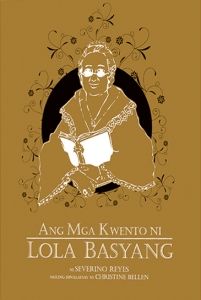
Ang Mga Kuwento ni Lola Basyang ni Severino Reyes by Christine Bellen
Lola Basyang is a household name in the Philippines. She’s an old lady, or lola in Filipino language, who loves to tell fantasy stories to children while sitting in a tumba, or a rocking chair. The character is also popular in the local movie and television industry.
Though it was Filipino writer Severino Reyes who created the stories of Lola Basyang, who has become something of an icon in the Philippines’ children’s book sector, Christine Bellen’s retellings in the mid-2000s through a set of picture books were a hit.
The picture books were reissued anew in 2017. “The Monkey Prince,” “Fearless Pedro,” and “The Palace of the Dwarves,” among others, are among the mythology short stories included. Illustrations by a variety of local artists are included in the picture books.

Good Night Philippines, Good Night World by Mila Bongco Philipzig and Frances Alvarez
This children’s book features 22 ways of saying “Good night, I love you” from the Philippines and around the world. Specifically, it highlights 11 Philippine languages and another 11 from other countries where Filipinos frequent: Saudi Arabia, Singapore, France, Canada, Malaysia, Japan, Italy, Ghana, Spain, Sweden, and Germany. On the other hand, the local languages featured are Ilonggo, Balangao, Kapampangan, Tausug, Ilocano, Cebuano, Kankanaey, Waray-waray, Kiniray-a, Bikolano, and Pangasinan. There are pronunciation tips here as well.
Usually, there’s a little bit of a story among families in these languages. This is a must-read Filipino children’s book for the future multilingual.
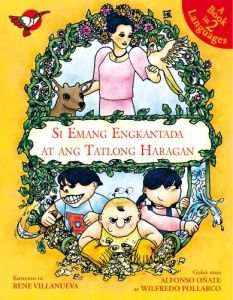
Si Emang Engkantada at ang Tatlong Haragan by Rene Villanueva, Alfonso Oñate, and Wilfredo Pollarco
Published in 1980, this is the most popular book by Rene Villanueva, an award-winning writer who made a great contribution to the local children’s book scene.
Si Emang Engkantada at ang Tatlong Haragan incorporates elements from Philippine mythology. It follows three children who do nothing but destroy the environment. They cut plants, throw garbage everywhere, and waste electricity. Emang Engkantada, an enchantress, teaches them a lesson by sending them to places where they would feel discomfort. Eventually, the three would regret their past actions and help Emang Engkantada.
The book is in English and Filipino.
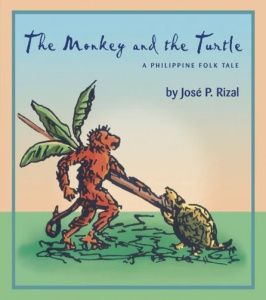
The Monkey and the Turtle by José P. Rizal
In the Philippines, José Rizal is known for many things: He is a martyr who stood up against the Spanish colonizers, a doctor, a lover, a hero, a writer, a poet, and a children’s book writer.
No one knows who originally wrote this Philippine mythology book, but José Rizal’s version is the most well-known. He even illustrated the cover himself. The Monkey and the Turtle tells the story of a foolish monkey and the clever turtle. The two animals find a banana tree and split it in two. The monkey gets the upper part of the plant while the turtle gets the lower portion, the one with the roots.
It’s a fun tale with plenty of lessons.
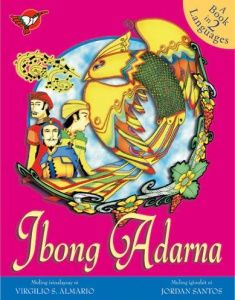
Ibong Adarna by Virgilio Almario and Jordan Santos
Like Rene Villanueva, Virgilio Almario is one of the greatest writers in Philippine literature, especially in the children’s literature scene.
Ibong Adarna is a 16th century folktale about a magical bird that can sing, but no one knows who actually wrote the tale. It’s a required reading in many schools. In the book, which is in English and Filipino, three princes go on a quest to capture the legendary bird in order to cure their ailing father, the king.
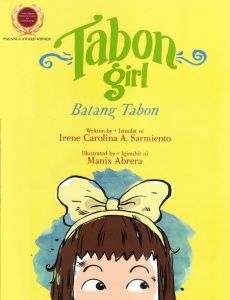
Tabon Girl by Irene Carolina Sarmiento and Manix Abrera
This children’s book revolves around the Tabon Man, one of the oldest Homo sapiens in the Philippines. The book touches on archaeology and a little bit of history as well through Mina, the protagonist. The illustrations pop, thanks to one of the most sought-after Filipino illustrators, Manix Abrera.
The text is in English and Filipino.
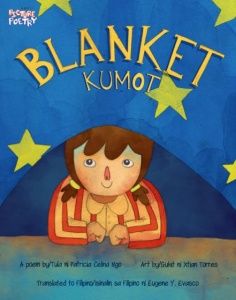
Blanket/Kumot by Patricia Celina Ngo and Xtian Torres
This one is a children’s poetry book. The poems are about a young girl who has a magical blanket (kumot in Filipino) that has the ability to turn into many objects, such a makeshift fort, a net for fishing, and a superhero cape.
Blanket/Kumot features poems accompanied by colorful illustrations, and the texts are in English and Filipino.
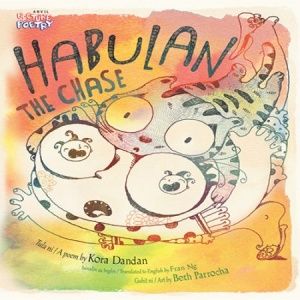
Habulan/The Chase by Kora Dandan Albano and Beth Parrocha
Habulan/The Chase features characters from Philippine mythology. Here, there’s a nuno sa punso, a dwarf-like creature living in a mound; a kapre, a tall tree demon that looks like a human and usually holds a tobacco pipe; and a manananggal, an evil spirit that detaches its upper body and sprouts bat-like wings.
The scenes are in colorful illustrations, and the text is supposed to be read out loud to kids.
Filipino Children’s Books: Beginning Chapter Books

Owl Friends by Carla Pacis
Published in 1997, this is a coming-of-age story that centers around identity. It gives spotlight to the Aeta, one of the Indigenous peoples in the Philippines.
Owl Friends follows Amelia and her family, who, after being displaced by the eruption of Mt. Pinatubo, moves to a settlement area. There, Amelia meets Johnny, an Aeta. At first, Amelia’s family is wary of Johnny. But later on, they would change their behavior toward him.
It’s a moving story about fighting racism and prejudice.
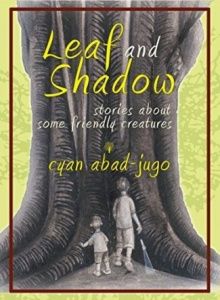
Leaf and Shadow by Cyan Abad-Jugo and Frances Alcaraz
This chapter book, written by one of the well-known children’s book writers in the Philippines, contains four short stories that feature some characters from Philippine folklore. These include an anito, or ancestor spirits, and a kapre. Usually, they are depicted as “friendly creatures” here.
This is a light read for kids who are into Filipino folklore.
Filipino Children’s Books for Middle Grade Readers
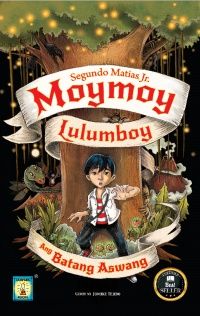
Moymoy Lulumboy: Ang Batang Aswang by Segundo Matias Jr.
This children’s fantasy series is aimed at middle grade readers. It features Philippine mythology characters such as aswang, tikbalang, and manananggal among others.
The book revolves around the titular character Moymoy Lulumboy, who is an orphan. As a baby, he was given to a saleswoman in a mall. As he grows up, he becomes unaware of his real identity — that he could be from a different world. This is an exciting story for kids to get started with Philippine mythology and folklore.
The book is followed by Moymoy Lulumboy: Ang Nawawalang Birtud, Moymoy Lulumboy: Ang Paghahanap kay Inay, Moymoy Lulumboy: Mga Dulot ng Digmaan, Moymoy Lulumboy: Ang Lihim ng Libro, and Moymoy Lulumboy: Ang Ugat at Ang Propesiya.
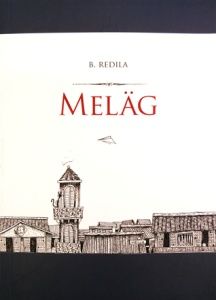
Meläg by Bong Redila
“Meläg” means “small” in Pangasinan, a Philippine language spoken in the northern province of the same name. Set in a fictional sleepy town of Meläg, this book contains nine comics and short stories aimed for young readers. As a Pangasinense myself, I relate to the comic panels here. They feel nostalgic, like remembering childhood memories.
Meläg won Best Graphic Literature in the Philippine edition of the National Book Award in 2017 and the Best Reads for Kids at the Philippine National Children’s Book Awards in 2018.
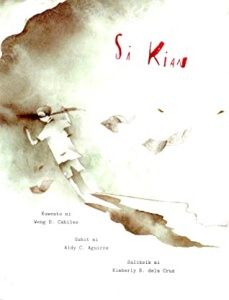
Si Kian by Weng Kahiles and Aldy Aguirre
In Rodrigo Duterte’s Philippines, an estimated 8,663 people were killed during his infamous “war on drugs,” according to the Human Rights Watch. Many believe, however, that the actual number could be thrice that.
Among those who were killed is a teen named Kian de los Santos, who was accused of being a drug runner. According to the reports, he was killed by the police in August 2017, which caused an uproar in the Philippines.
In this picture book aimed at young readers, the authors tell the life story of Kian de los Santos. The Philippine Center for Investigative Journalism contributed to the research. It won Best Reads for Children at the National Children’s Book Awards in 2018 in the Philippines.
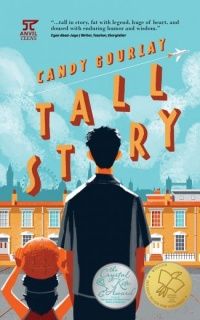
Tall Story by Candy Gourlay
Set in England, the book follows Andi, who loves basketball. When her mom, who works in the UK, announces that her long-lost brother Bernardo is coming to England, Andi is thrilled. Little does she know that her brother is very tall.
Tall Story was first published by Filipino publisher Anvil Publishing in 2010. Then it was picked up by David Fickling Books in the UK. It won Best Reads for Children at the Philippine National Children’s Book Award in 2012 and the Crystal Kite Awards in Europe in 2011. Last year, it was included among the best books of the last 100 years in the UK.
Evidently, Filipino children’s books offer variety in terms of genre and subjects: the stories feature mythology, folklore, social justice, coming of age, and so much more.
Ready to give Filipino books for adults a try? Here are 5 Must-Reads of Philippine Literature and the Best Filipino Horror Books to add to your TBR!
Source : 15 of the Best Filipino Children’s Books from the Philippines














